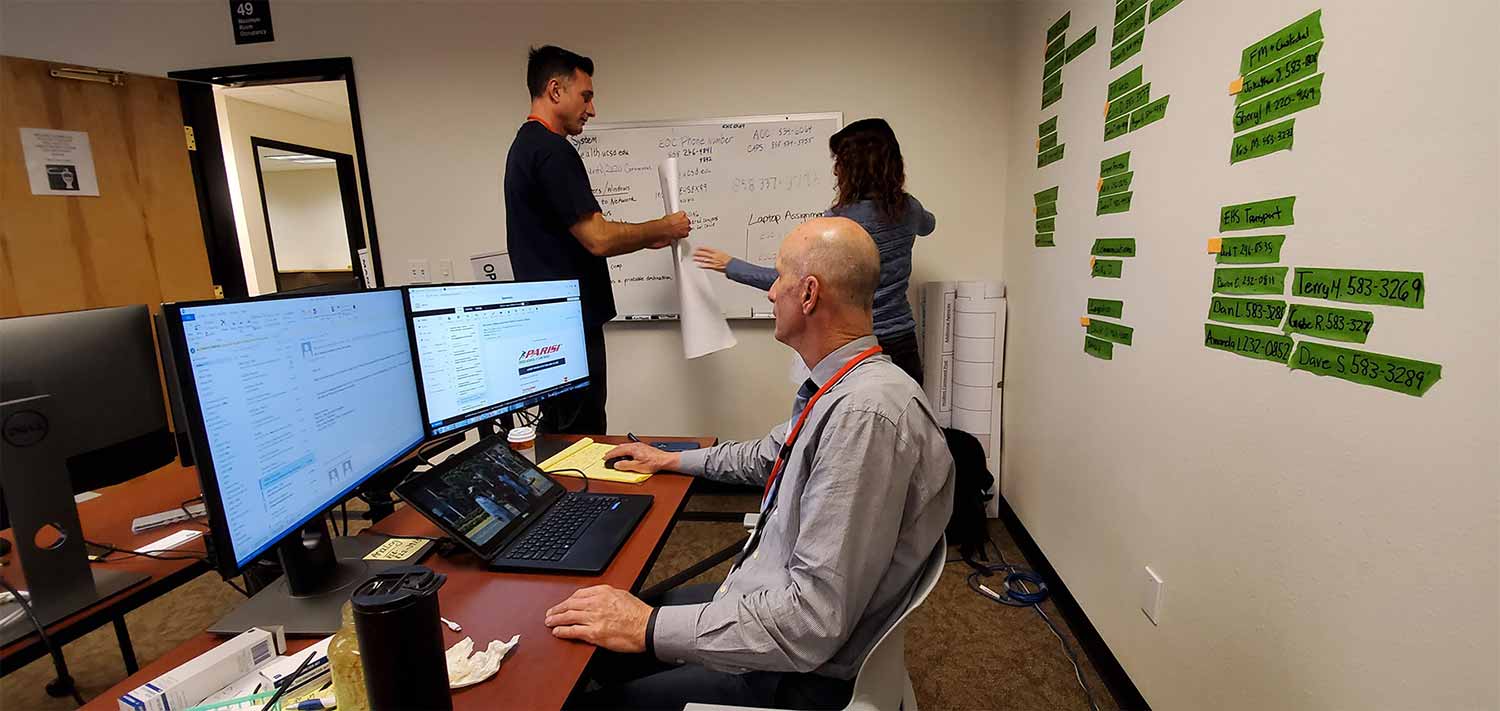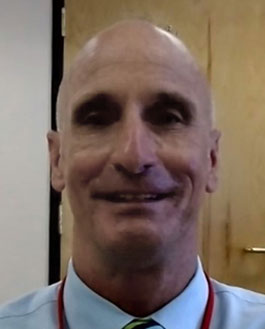
By:
- Erika Johnson
Published Date
By:
- Erika Johnson
Share This:

Dismas Abelman, Emergency Manager at UC San Diego, and staff in the Emergency Operations Center. This photo was taken prior to the face-covering mandate. Photo by Erika Johnson.
Q&A: What is the Role of the Emergency Operations Center?

UC San Diego’s fall plan continues to evolve, informed by the university’s Return to Learn program. We invited students, faculty and staff to submit their questions about how the university coordinates an emergency response to protect the campus community, how critical decisions are made and communicated and what a typical day is like at the Emergency Operations Center. For a behind-the-scenes look at these processes, we spoke with Dismas Abelman, Emergency Manager at UC San Diego.
Q. What is the Emergency Operations Center?
A. The Emergency Operations Center (EOC) is the hub for information management, decision making, and resource support and allocation during an emergency response. When an emergency happens, the EOC is activated and a central location is established on campus to guide actions. It is our role to make sure that policy-level decisions from the Chancellor and campus leadership are achieved.
We have established key communication relationships so that we are able to mobilize resources where needed. Our team is comprised of managers from all areas of campus, from Academic Affairs and Human Resources to Housing, Dining, Hospitality and Facilities Management. We also maintain direct contact with the UC Office of the President, Governor's Office of Emergency Services, San Diego County and City Offices of Disaster Preparedness and the news media.
Q. What constitutes a campus emergency?
A. A campus emergency is an incident that takes place either on campus or nearby campus that has an effect on our population.
There are three levels of activation:
Level 1: The emergency cannot be managed using normal campus resources and a campus state of emergency may be declared. An event of this nature could include a large earthquake that would require the assistance of resources from off campus agencies.
Level 2: An emergency that affects many people and requires a multi-unit response. An example of this could include a fire or a chemical release into the atmosphere. Impacts of an event of this nature could include large-scale evacuation and the need to access off-campus emergency response resources.
Level 3: This type of emergency can be managed using existing resources and response procedures—for instance, a small-scale, localized problem contained to a single space such as a laboratory—and does not involve evacuation of large numbers of personnel (if any).
We activated to level 3 on Jan. 27, 2020 to prepare for potential impacts to our campus as the pandemic began to grow. During this time, we began to meet virtually on a daily basis. As the situation evolved, we activated to a level 2 on March 5, 2020, which meant we were physically all in the same room together sharing information and making decisions.
Q. What is a typical day like at the Emergency Operations Center?
A. There really is no typical day. We're constantly collecting information, such as new orders from the County based upon guidelines from the State. We evaluate how these decisions impact our campus and how we are going to achieve it. Or we may look at the information we're seeing from other universities that are now having outbreaks and adjust our plan to protect our campus community.
Our activity happens in waves. Some information and directives must be acted on immediately; others lead us into a planning stage that may take days or weeks. When we first activated the EOC, the pace was nonstop; we worked 12-hour days. We were getting information, making decisions and implementing them. Now, the pace has become more methodical. We are still getting information, the center is open 12 hours a day, and we are in constant communication. Phone calls that come in are forwarded to us so that we can respond if needed even after hours.
Q. How has the response to the COVID-19 pandemic been different or more challenging than other emergencies in the past?
A. The most recent activation of the EOC prior to the pandemic was a power outage. We’ve also been involved in wildfire response, when air quality becomes an issue. The COVID-19 pandemic response has been completely different than any other emergency response I've ever seen in my life. It is so complicated and has so many different facets to it. It's been a fascinating case study in emergency management.
What makes it complex is the ongoing nature of the emergency. For instance, during a power outage—the power goes out, you respond to it, then you begin the recovery phase. When the pandemic came along, we immediately started thinking about how do we protect our campus? We transitioned finals to a virtual format; then we started talking about the next quarter going virtual, moving staff to remote work. Every one of those actions had this amazing complexity to it. We're still in the response, but also working on a recovery at the same time. It's completely unusual. It's been so much of everything.
I'm extremely proud of our staff, who have put the needs of our students and community first. And I'm proud of our community as a whole. I think we've done a good job of taking care of each other. The people in the EOC are working very hard to make sure that we are all safe and people are well cared for. I'm grateful for the strong leadership we've received and the very clear message that our people are our most valuable resource.
Q. How has the EOC response evolved?
A. Initially when the EOC was activated, we were making decisions about all campus activities, from student isolation to helping with sanitation and moving staff to remote work. We were involved in the intricacies. Now, we are more in a support role because we have established a solid framework for response and resources in many divisions. We make sure they have the equipment they need and plans for their location. This includes return to campus procedures for departments that includes space planning to implement physical distancing, disinfection guidance and food facility operations. We have also established guidelines for the public, how to report health and safety concerns, vehicle disinfection methods as well as provide health education posters and signage on our COVID-19 Campus Resources and Guidelines page.
Q. Who makes key decisions about campus operations?
A. The Executive Policy Group, or EPG, is responsible for making policy-level decisions. This group is comprised of the Chancellor, Executive Vice Chancellor, Vice Chancellors and other campus leaders. These directives come to us in the EOC, and the directors of the different departments staff up teams such as finance, logistics, operations, management and planning. From there, plans for how to proceed are put into place. It's a very structured chain of command.
Q. How do you communicate emergency information with the campus community?
A. Yes, we use multiple channels to help keep our campus population as informed as possible. One of our primary platforms is our Triton Alert mass notification systems to send important messages by text and email (you will see Everbridge as the sender). All faculty, staff and students are automatically opted in to receive emails; the campus community is also able to sign up to receive text messages. You can adjust your preferences any time, but your UC San Diego email address can’t be removed.
University Communications also plays a key role through their Crisis Communications Plan, which outlines staff members who are called upon and the steps needed for effective internal and external communication. There are internal and external communication representatives who ensure information is distributed across campus websites and accurate updates are provided to news media. There is also a dedicated web team and social media team that shares critical messages across the university’s digital channels.
Q. Does the EOC regularly practice emergency response?
A. Yes, when we are not activated and responding to an emergency, the EOC team meets every other month to practice creating a response to potential emergencies, from cybersecurity threats to fire and earthquakes. Although each situation is different, it is key to practice responding under pressure, with limited information. It is also important for the team to build relationships and trust by meeting together often.
Have more questions? We invite the campus community to submit your inquiries online. A new Q&A with a Return to Learn expert will be published each Thursday in This Week @ UC San Diego for the next several weeks.
Share This:
You May Also Like
Stay in the Know
Keep up with all the latest from UC San Diego. Subscribe to the newsletter today.


